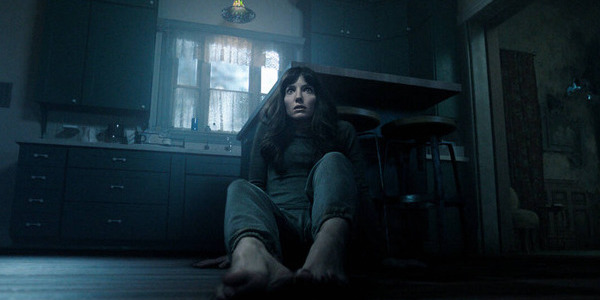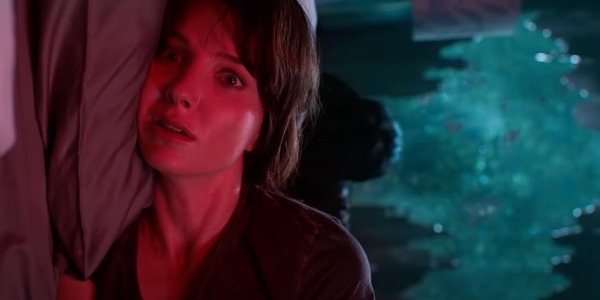While Everyone’s Still Talking About M3GAN, Let’s Talk About MALIGNANT

Payton McCarty-Simas is a freelance writer and artist based in…
Much has been said about the “cult” status of M3gan and its now-instantly recognizable singing, dancing, sunglasses-wearing titular murder doll. The validity of that description is nuanced, but almost any cult credibility that can be attributed to M3gan is owed to the film’s screenwriter, Akela Cooper. Sadly, Cooper‘s incredible screenplay for the maniacally gory, slyly hilarious, tragically underrated, genuine cult object that is James Wan‘s Malignant (2021) hasn’t received the same attention.
M3gan: Cult Film?
Let’s start with M3gan. As a queer person who’s even vaguely online, I was immediately aware of M3gan herself (my introduction to the meme came from a King Princess instagram post). The brilliantly tactical hype campaign for the film that highlighted pretty much all of its interesting moments in the trailer meant that long before the film’s release everyone I knew was talking about it. Articles immediately declared the film to be “already be a cult classic” – a potentially oxymoronic description for a film that made $45 million internationally in its opening weekend and is still making headlines like this one. Cult films have traditionally been defined by some combination of their “badness” – a fundamental air of trashiness that’s often related to their genre (usually horror), lack of craft, or (often) low budget and prompts exclamations like “it’s so bad it’s good!” – their ultra-dedicated, actively participatory fanbase (think The Rocky Horror Picture Show or The Room), and a compulsive rewatchability that can stem from a desire to analyze their intricate and often confusing plots (Donnie Darko), to revel in their campy dialogue/sensibility (Showgirls), or merely marvel at their general bizarreness (Troll 2).
Historically, the cult label had been reserved for films that were unsuccessful on their release but came to be precious to the small subculture that loved them. A Nightmare on Elm Street 2 for example flopped at the time but had a tremendous fan base among gay men for its queer-coded male scream queen. As media scholar Anne Jerslev argued in the 90s, though, this particular definition, with its subversive, countercultural connotation, has become less useful since the cult label has been appropriated into corporate marketing strategies and advertising campaigns for films before they are able to organically garner their own fanbase.

M3gan, then, exists in a grey area between definitions of cult filmmaking. M3gan herself has been lauded as a gay icon by fans (including NYU film professor Joe Vallese, whose area of study includes cult and horror films) in keeping with the longstanding tradition of queer people embracing the villains of horror as representatives of our own Otherness. Her dance moves did become a viral sensation, rewatched by millions of adoring fans before she even hit theaters with her aloof, snarky presence, however (as has been pointed out before) the film’s marketing strategies seemed calculated to invite – nay, beg for! – this treatment by foregrounding the campier elements of its plot. Indeed, the King Princess post that first caught my attention was an advertisement for their most recent album, highlighting its status as a marketing tool as well as a meme. M3gan‘s success is thus both popular and corporate, both deliberately manufactured and willingly accepted.
So, is M3gan actually good at the end of the day? According to many, it doesn’t matter. And it doesn’t! The entire appeal of the film is in its few standout, meme-able moments – its now-cult moments. The film has been buzzily praised by writers who describe themselves as “scaredy cats” for its title character and not much else. Its quippy, subgenre-blending script serves up a film whose PG-13 scares are great for a non-horror-buff audience. There’s a lot to like about the film’s themes of nontraditional family and gender trouble – robots, androids, murder dolls and other nonhuman villains are deeply queer in their oft-doomed quest to perform whatever gender they’re assigned, from Hal to the Stepford Wives to Chucky’s nonbinary child (watch Seed of Chucky, I promise) and beyond.
Malignant: Fabulously Gonzo
Which brings us to Malignant. Unlike M3gan, Malignant, Akela Cooper‘s genuinely bizarre previous film, found its cult following on its own. Another playful take on gender and genre-bending whose R-rated gore (the film has a significantly higher kill count than many other recent horror films), virtuosic gore and practical effects, and confident direction by horror virtuoso James Wan, is perfectly suited for horror aficionados and midnight movie lovers… if not necessarily the broad audience won over by M3gan‘s crooning, shimmying antics. Hampered by the inflated costs of pandemic production and a same-day release on HBOMax, the film, like many traditional cult classics from Rocky Horror to Jennifer’s Body, was relatively unsuccessful upon its release. That being said, in large part due to Akela Cooper‘s fabulously gonzo pulp-infused script, the film has subsequently gained a cult fandom, complete with lovingly rendered fan art, ships with other horror villains, and midnight screenings.
In style, the film is a masterful, deliciously wicked nod to the tradition of 1970s and 80s exploitation filmmaking (Cooper‘s script gives us a lesbian girl gang prison scene worthy of Caged Heat [1974] that’s genuinely hard to believe comes from this decade) of the kind championed by the likes of Frank Henenlotter, whose seminal shocker Basket Case (1982) arguably influenced the film’s own twisted plot. Malignant follows a nurse, Maddy (Annabelle Wallis), on her journey to help the police track down a killer whose crimes she is inexplicably able to envision as they occur – and that’s about the most I can say without giving anything crazy away.

Spoiler for Malignant ahead:
Though description truly can’t capture how mind-boggling this film is as an experience – it really needs to be seen to be believed – here’s the plot: As it turns out, an attack by Maddy’s abusive dirtbag boyfriend after she distracts him from watching the big game cracks open her skull, releasing her evil, telekinetic, parasitic twin Gabriel from the entrapped dormancy imposed on him by evil scientists who unceremoniously stuffed him under her parietal bone in the film’s cold open. Their shared-brain connection allows Gabriel to control Maddy’s body from the back of her head like an evil Jim Henson puppet, killing all those who wronged him – and anyone who gets in his way.
The relationship between Maddy and her brother Gabriel is fascinatingly trans-coded as the two fight for control of their shared female body. Though Gabriel’s bloodlust clearly marks him as the villain, this poor, ugly creature is undeniably sympathetic for his sense of injustice at his treatment at the hands of an uncompromising medical establishment who views him as a perverse “cancer” on Maddy’s otherwise well-adjusted feminine body. While Maddy has other avenues for family ties and a happy life, Gabriel, the mercenary twin, must attempt to seize, by violence if necessary, the only form of life he is afforded by the circumstances of his birth literally “in the wrong body.”

A cult sensibility pervades. The character design is suitably nasty, with Maddy-Gabriel flailing around with an uncanny combination of disarticulated jerkiness and sinewy slithering. True to its exploitation film roots, the dialogue in this film is delightful, full of hilariously banal on-the-nose lines like, “BABE, I was WATCHING THAT!” and “It’s like he’s BROADCASTING HIS THOUGHTS! It’s like he’s DRINKING THE ELECTRICITY!” The origins of this monster are ambiguous, either a product of weird science or God’s wrath or both. Accordingly, the film’s grab-bag of generic conventions works in unholy concert, combining elements of mystery, police procedural, science fiction thriller, found footage, and supernatural horror with ease. The actors chew the scenery with abandon even as the direction and visual effects lead the viewer through an impressive maze of haunted houses, abandoned hospitals, and police headquarters.
Conclusion:
Watching Malignant for the first time, I quickly noticed my jaw was on the floor. As a woman in a princess dress tells the police to call a psychic and an instrumental cover of “Where Is My Mind?” plays (it turns out to be the film’s main piece of score, I’m not kidding), I found myself cackling and gasping in turn with the kind of incredulous glee I go to movie theaters hoping to find. Malignant embraces the true cult sensibility that M3gan only gestures to, serving up a wildly entertaining and singular cinematic experience undergirded by satisfyingly effective technical craft. Its bold, gleeful play with genre and irreverent use of kitsch, cheese, and sleaze, make it much worthier of the label an “instant cult classic.”
Does content like this matter to you?
Become a Member and support film journalism. Unlock access to all of Film Inquiry`s great articles. Join a community of like-minded readers who are passionate about cinema - get access to our private members Network, give back to independent filmmakers, and more.
Payton McCarty-Simas is a freelance writer and artist based in New York City. They grew up in Massachusetts devouring Stephen King novels, Edgar Allan Poe stories, and Scooby Doo on VHS. Payton holds a masters degree in film and media studies from Columbia University and her work focuses on horror film, psychedelia, and the occult in particular. Their first book, One Step Short of Crazy: National Treasure and the Landscape of American Conspiracy Culture, is due for release in November.













